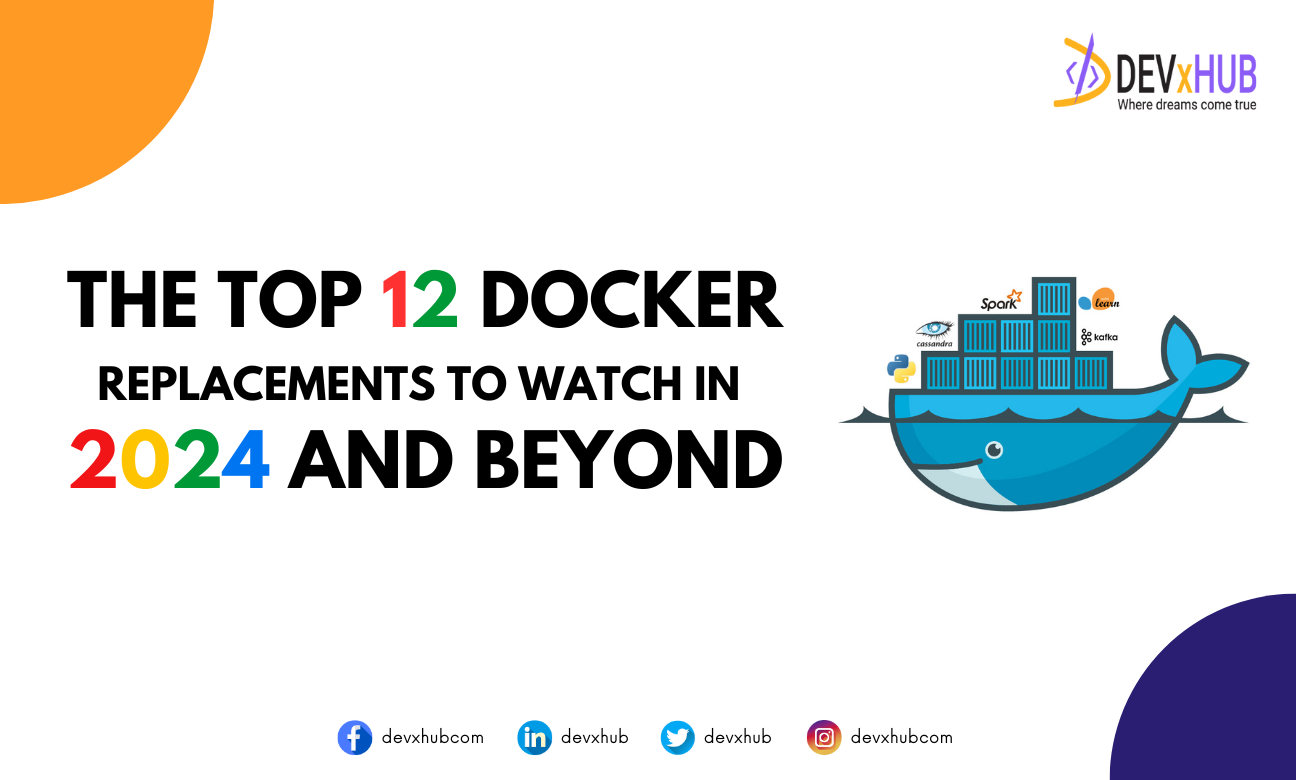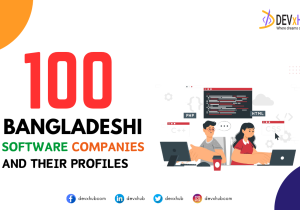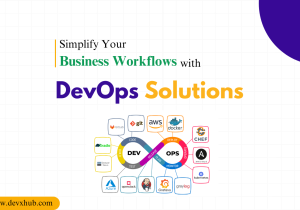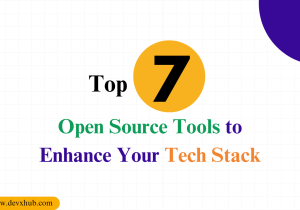Blog - The Top 12 Docker Replacements to Watch in 2024 and Beyond
Docker has undeniably been groundbreaking in the realm of containerization technology. However, as we enter 2024, it’s becoming increasingly evident that exploring alternatives to Docker is essential for the evolution of containerization. Several feature-rich alternatives have emerged in the market, poised to invigorate containerization technology in the coming year.
Before we delve into these alternatives, let’s first examine what Docker technology entails and why it has been so widely adopted.
Docker is an open-source containerization technology rooted in Linux. It serves as a robust platform for building, running, inspecting, and managing container images to facilitate application development. Its comprehensive ecosystem offers an extensive toolkit for streamlining the containerization process.
Docker’s Features and Advantages
Docker has revolutionized application deployment and management by offering a host of features and benefits that enhance development workflows and operational efficiency.
Key Features of Docker:
1. Containerization: Docker encapsulates applications and their dependencies into containers, ensuring consistent performance across diverse environments.
2. Platform Agnosticism: Docker containers are compatible with any infrastructure supporting Docker, ensuring flexibility and mitigating compatibility issues.
3. Version Control: Docker facilitates versioning of container images, enabling seamless rollbacks and ensuring reproducible deployments.
4. Modularity: Docker enables the decomposition of applications into smaller components, simplifying maintenance and updates.
Benefits of Docker:
1. Consistency: Docker promotes uniformity across development, testing, and production environments, reducing deployment discrepancies.
2. Speed: Docker expedites development cycles through rapid container deployment and teardown.
3. Isolation: Docker provides robust isolation between applications and dependencies, bolstering security and performance.
4. Portability: Docker containers are effortlessly portable across different environments, streamlining deployment processes.
Why Consider Alternatives to Docker
Despite its widespread adoption, there are several reasons driving the demand for alternatives to Docker. These reasons often stem from perceived shortcomings of Docker technology:
1. Complexity: Docker necessitates a deep understanding of containerization processes, making it challenging for novices to create, manage, and maintain Docker files.
2. Security Vulnerabilities: Misconfigurations in Docker containers can expose applications to security risks, posing liabilities to users.
3. Performance Limitations: While Docker containers are generally efficient, they may not be optimal for resource-intensive applications requiring high performance and low latency, as resources are shared with the host system.
4. Unsuitability for GUI Applications: Docker, primarily designed for isolated containers, may not offer optimal performance for GUI-based applications, limiting its utility in certain contexts.
In response to these limitations, numerous alternatives to Docker have emerged in recent years. Here is a curated list of tools and platforms that address these concerns while providing comparable containerization features.
Top Docker Alternatives to Consider in 2024
1. Containerd
Containerd stands out as a prominent alternative to Docker, compatible with both Linux and Windows environments. Serving as a container runtime, Containerd offers a comprehensive suite of tools to manage the complete lifecycle of containers on its host system. This includes functionalities such as image transfer, storage management, container execution, supervision, as well as low-level management of network attachments and beyond.
Key Features of Containerd:
– Support for pushing and pulling images
– Network primitives facilitating creation, modification, and deletion of interfaces
– Multi-tenancy support with CAS storage for global images
– Compliance with OCI Runtime Spec (also known as runC)
– Extensive support for container runtime and lifecycle management
– Ability to manage network namespace containers to join existing namespaces
Why Opt for Containerd over Docker?
In comparison to Docker, Containerd presents itself as a simpler, more streamlined low-level Daemon program, offering all the essential features necessary for container construction. It boasts a reduced level of complexity while maintaining flexibility in creating basic containers.
2. Podman
Podman emerges as a noteworthy alternative to Docker, offering a daemon-less, open-source solution native to Linux. It facilitates the deployment, building, and sharing of containers by leveraging the Open Containers Initiative (OCI) standards.
Similar to other container engines and runtimes, Podman operates on OCI containers, ensuring that containers produced are nearly indistinguishable from those created by Docker. Its Command Line Interface (CLI) closely resembles that of Docker, simplifying the transition for developers. Additionally, aliasing Docker to Podman is straightforward, allowing even novice users to run containers seamlessly.
Key Features of Podman:
– Supports rootless containers, eliminating the need for running privileges.
– Adaptable to various computing environments and configurable according to specific requirements.
– The ‘Podman Top’ display command provides comprehensive information on running container processes.
– Simplifies container execution through the creation of Systemd files, making running containers as simple as writing a file.
Why Opt for Podman Over Docker?
Unlike Docker, which relies on a persistent, self-contained runtime managed by its daemon (Dockerd), Podman operates without a daemon. It initiates containers as child processes and interacts directly with the registry, offering a leaner approach to container management.
3. Buildah
Buildah is another notable open-source tool designed for Linux environments. It facilitates the creation of OCI-compatible containers that are not only compatible with Docker but also with Kubernetes. Buildah allows users to build images from scratch or extend existing base images, offering a flexible and secure method for container image creation.
Key Features of Buildah:
– Builds container images with or without Dockerfiles, providing flexibility in image creation.
– Enables the creation of container images from scratch or based on existing images.
– Supports building tools within the image itself, reducing image size and increasing security.
– Compatibility with Dockerfiles facilitates a seamless transition from Docker.
Why Choose Buildah Over Docker?
Buildah distinguishes itself with its advanced container-building capabilities. Unlike Docker, which primarily supports basic container creation, Buildah offers more sophisticated features and cleaner Docker images. Its scripting capabilities surpass those of Docker, enabling users to create customized and optimized container images.
4. Vagrant
While Docker focuses on containerization, Vagrant adopts a different approach by providing a platform for managing virtual machine (VM) environments within a unified workflow. It facilitates the creation of VM environments compatible with hypervisors and cloud VMs, offering an efficient configuration format.
Key Features of Vagrant:
– Interoperability with other Continuous Integration (CI) tools, enabling seamless integration into automated testing and build pipelines.
– Supports multi-machine environments compatible with various operating systems.
– Facilitates the sharing of base images via its cloud infrastructure.
Why Choose Vagrant Over Docker?
Unlike Docker, which primarily targets Linux systems, Vagrant is compatible with multiple operating systems. Additionally, Vagrant offers enhanced security features compared to Docker, making it an attractive option for users concerned about security.
5. LXD
LXD presents itself as a robust alternative to Docker, serving as a powerful VM machine manager and container system. It supports Ubuntu images and seamlessly distributes them across Linux systems. Leveraging a potent REST API, LXD can effortlessly scale from a single machine to an entire cluster, making it suitable for both development and production environments. Notably, LXD boasts lightweight containerization with speedy data processing, utilizing Linux kernel features such as control groups and namespaces for visualization.
Key Features of LXD:
– Flexible resource allocation, including CPU, memory, network I/O, disk space, and various kernel resources.
– Advanced snapshot capabilities with scheduling and automatic expiry functionalities.
– Simple multi-user setup with enhanced security measures.
– Support for live migration, stateful snapshotting, and hardware passthrough (e.g., GPU, USB, NIC, disks).
– Advanced networking support, including OVN, SR-IOV, and hardware acceleration.
Why Opt for LXD Over Docker?
– LXD demonstrates superior speed over Docker, especially in scenarios involving multiple processors.
– With its longer tenure and robust capabilities, LXD excels in managing larger resource lists compared to Docker.
6. Kubernetes
Kubernetes emerges as a preferred alternative to Docker for many developers due to its comprehensive container management capabilities. While Docker focuses primarily on container runtime and environment, Kubernetes serves as a platform for running and managing containers from various runtimes. Kubernetes excels in handling scalability challenges posed by Docker, accommodating a vast number of containers originating from different runtime environments.
Key Features of Kubernetes:
– Automatic scaling of containerized applications and resources based on demand.
– Automated deployment and update processes with rollback capabilities.
– Declarative model for specifying desired states, with Kubernetes ensuring continuous maintenance and recovery.
– Dynamic storage provisioning to meet evolving requirements.
– Support for DevSecOps practices, enhancing developer productivity.
Why Choose Kubernetes Over Docker?
– Kubernetes serves as an orchestrator for Docker containers, streamlining deployment, scaling, and operational tasks.
– Kubernetes excels in executing, creating, and deploying complex containers, offering capabilities beyond Docker’s scope.
7. Rancher
Rancher emerges as a comprehensive solution for teams adopting containerization, addressing operational challenges associated with maintaining Docker and Kubernetes clusters. It offers a complete software development stack, integrating tools for running containerized workloads efficiently.
Key Features of Rancher:
– Cross-host networking support, establishing private software-defined networks for secure communication.
– Container load balancing to optimize container distribution across processors.
– Distributed DNS-based service discovery, enabling automatic container registration over the network.
– Resource monitoring and container deployment management directly from Docker Machine.
Why Choose Rancher Over Docker?
– Rancher provides advanced containerization management features surpassing Docker’s basic functionalities.
– As an open-source solution, Rancher is cost-effective and can replace Docker Desktop while serving as an extension of Kubernetes.
8. OpenVZ
OpenVZ stands out as an open-source, container-based virtualization solution tailored for Linux environments. It facilitates the secure isolation of multiple Linux containers on a single physical server, thereby enhancing server utilization and preventing application conflicts. With a plethora of features, OpenVZ serves as a dependable alternative to Docker.
Key Features of OpenVZ:
– Lightweight OS-level virtualization ensures fast container startup times and reduces total cost of ownership (TCO).
– Quick resource allocation facilitated by a self-service portal.
– Reliable snapshots and image backups improve business continuity.
Why Opt for OpenVZ Over Docker?
– OpenVZ demonstrates superior efficiency in memory and CPU usage compared to Docker.
– Its support for shared kernel usage among multiple containers optimizes memory utilization, whereas Docker containers are entirely isolated from one another.
9. VirtualBox
Oracle VM VirtualBox offers a comprehensive virtualization solution, enabling the emulation of complete operating systems within virtual machines (VMs). It is a widely adopted open-source, cross-platform software that facilitates running multiple operating systems on a single physical host.
VirtualBox’s popularity stems from its ability to reduce operational costs by allowing the simultaneous execution of multiple OS environments on various platforms, including Windows, Linux, MacOS X, and most x86 systems.
Key Features of VirtualBox:
– Portability across a wide range of 64-bit hosts.
– Compatibility with older-generation hardware lacking advanced processor features such as Intel VT-x or AMD-V.
– Integration of Guest Additions software packages within guest systems to enhance performance and provide additional integration options.
– Extensive hardware support, including Guest Multiprocessing (SMP), ACPI support, built-in iSCSI support, and more.
Why Choose VirtualBox Over Docker?
– Unlike Docker containers, VirtualBox VMs do not impose resource usage limits, offering greater flexibility.
– VirtualBox provides enhanced security for application segregation and isolated environments, minimizing single points of failure.
10. Portainer
Portainer emerges as an exceptional alternative to Docker, offering a user-friendly, visual representation of containers and their associated applications. As an open-source service, Portainer provides a web-based interface for container management, supporting various containerization software such as Docker, Kubernetes, and Azure Container Instances (ACI).
With Portainer, developers can easily deploy and manage Docker containers without the need for extensive CLI commands, thanks to its intuitive GUI. Key features of Portainer include:
Features of Portainer:
– Simple deployment of containerized applications through intuitive interfaces and step-by-step guides.
– Seamless management of multiple containers across different containerization platforms, including Docker, Docker Swarm, Kubernetes, and Azure ACI.
– Enhanced container security with customizable user roles and permissions within container environments.
– Convenient scalability options, allowing developers to scale services as needed directly from the Portainer interface.
Why Opt for Portainer Over Docker?
– Centralized management of Docker instances from a single interface simplifies container administration, especially across remote systems.
– Portainer’s visual representation of containers, images, and networks is particularly beneficial for users new to containerization, facilitating easier understanding and management.
11. RunC
RunC serves as a lightweight and portable container runtime, offering full compatibility with Docker’s plumbing code while focusing on security. Unlike Docker, RunC does not rely on the entire Docker ecosystem but instead utilizes its runtime, providing a secure and efficient container execution environment.
Features of RunC:
– Comprehensive support for Linux namespaces and native integration with all available security features in Linux.
– Facilitates live migration through CRIU teams at Parallels.
– Supports complex hardware features such as DPDK, SR-IOV, TPM, secure enclave, and more.
Why Choose RunC Over Docker?
– RunC is a versatile tool suitable for running containers in various contexts, including Docker, Containers, and CRI-O.
– Its simplicity and efficiency contribute to the overall ease of use of containerization tools.
12. Kaniko
Kaniko earns its place as a top Docker alternative by addressing the need to build container images without requiring root access. This tool enables users to build container images directly from Dockerfiles, eliminating security concerns associated with root privileges and streamlining the image-building process.
Features of Kaniko:
– Independence from a Docker daemon enhances security and reduces overhead.
– Builds container images without requiring root privileges, ensuring better security.
– Integrates seamlessly with Kubernetes pods, providing access to the latest container image-building features.
Why Choose Kaniko Over Docker?
– Kaniko offers a distributed and efficient approach to building container images, outperforming Docker in terms of performance, cache utilization, and security.
– Kaniko provides a more isolated and reproducible build environment compared to Docker, offering developers greater flexibility when working with container images.
Docker Alternatives: Final Words
Docker has long been a frontrunner in the realm of container runtimes; however, numerous alternatives with enhanced features have emerged in the market. While Docker remains a popular choice for containerization among millions of developers, Kubernetes is steadily gaining traction, leading to a continuous demand for skilled professionals proficient in Kubernetes environments and other containerization tools.
Despite many companies promising reliable development through containerization technology, only a select few can truly deliver on their promises. OpenXcell stands out as one such company, demonstrating prowess in software development and DevOps Containerization Services.
With a diverse portfolio of successful software projects launched into the market, OpenXcell has garnered widespread acclaim. Its extensive client base further attests to the high-quality solutions the company consistently delivers.
Related Posts
Categories
- App Development (2)
- Design (2)
- DEVxHUB (30)
- Digital Marketing (2)
- Guide (24)
- It Bangladesh (1)
- Logo design (1)
- Operating system (1)
- Personal Improvement (14)
- Planning (4)
- Project management (3)
- Social media (2)
- Software Development (5)
- Software Quality Assurance (8)
- Startups (1)
- Team work (1)
- UI UX (1)
- Web Development (6)
Main Tags
- 2024
- Android
- app development
- bangladesh
- content writing
- design
- devxhub
- Digital marketing
- Guide
- IOS
- It
- logo design
- Operating system
- Personal Improvement
- planning
- project management
- social media
- Software Development
- Software Quality Assurance
- software testing
- software testing types
- Startups
- Success
- team
- UI UX
- UI UX design
- VR
- Web Development















